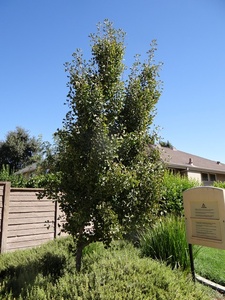 A young Ginkgo tree in Jeff Roddy Memorial Park.Ginkgo Trees (Ginkgo biloba), also called Maidenhair Trees, are tall coniferous trees from China that are considered "living fossils" because all their close relatives are extinct. Their leaves are uniquely fan-shaped, visually resembling the pinnae of maidenhair ferns.
A young Ginkgo tree in Jeff Roddy Memorial Park.Ginkgo Trees (Ginkgo biloba), also called Maidenhair Trees, are tall coniferous trees from China that are considered "living fossils" because all their close relatives are extinct. Their leaves are uniquely fan-shaped, visually resembling the pinnae of maidenhair ferns.
In Woodland, Ginkgos are planted at Campbell Park, City Hall, Everman Park, Jack Slaven Park, Jeff Roddy Memorial Park, John Ferns Park, Ralph Harris Park, Rick Gonzales, Sr., Park, Streng Park, William Crawford, Sr., Park, Woodland City Cemetery, Woodland Off-Leash Dog Park, Woodland Sports Park, and Woodside Park. It is also planted as a street tree on 1st Street, 2nd Street, 3rd Street, 4th Street, 5th Street, Bliss Avenue, College Street, Cross Street, Elm Street, Grand Avenue, Marshall Avenue, North Street, Oak Avenue, Palm Avenue, and Pendegast Street.
Additionally, the cultivar 'Sky Tower' is planted as a street tree on County Road 98.
Cultivation
Ginkgos are large trees, typically 70 to 120 feet tall, sometimes more than 150 feet tall. They have narrow, sparse crowns when young, filling out as the tree ages. They are believed to live to be over 2,500 years old. Well-established Ginkgo trees can produce aerial roots on the undersides of large branches so that if those branches fall, they can sprout and grow where they fall. Ginkgo trees prefer full sun, regular water, and good drainage.
The 'Sky Tower' cultivar is a dwarf male Ginkgo, selected to grow only 15 to 20 feet tall and 6 to 10 feet wide.
Advantages
Ginkgo trees are very resistant to disease and insects. Their lack of close relatives makes it harder for diseases or insects to adapt to them. Ginkgo trees also can tolerate pollution and having their roots narrowly enclosed by pavement. Additionally, they are often planted for their bright yellow fall color.
Disadvantages
Ginkgo leaves contain urushiol, the allergenic oil that is also produced by poison oak. If you're significantly sensitive to it, you can get the same rash from touching Ginkgo leaves as you would get from touching poison oak leaves.
Additionally, female Ginkgo trees produce very unpleasant-smelling seeds. They are sometimes described as smelling like vomit.
Because of this problem with female Ginkgo trees, the vast majority of planted Ginkgo trees are male. However, male Ginkgo trees are the ones that produce pollen, and the male trees are ranked 7 out of 10 on the Ogren Plant Allergy Scale, indicating a tendency to cause fairly severe hay fever. If the City of Woodland has planted a male Ginkgo tree near your home and you suffer from terrible hay fever each spring, the Ginkgo tree could be causing your hay fever. Check the hay fever page for more information.
History
Fossils in the genus Ginkgo first appeared in the Middle Jurassic epoch, approximately 170 million years ago. The genus Ginkgo diversified and spread throughout Laurasia during the Jurassic and Early Cretaceous but declined in diversity during the Late Cretaceous (the period when flowering plants first arose). At the end of the Pliocene, all fossils in the Ginkgo genus—and also the Ginkgo family and the entire order Ginkgoales—disappeared from the fossil record everywhere except in a small area of south-central China (the Tibetan Plateau), where only the species Ginkgo biloba survived.
Taxonomy
Modern Ginkgo biloba trees are the only living species in their genus, family, order, class, and division (Ginkgophyta). The closest living relatives of Ginkgo trees are cycads. Ginkgo trees are considered gymnosperms because their seeds are not protected by an ovary wall; however, their relationship to conifers remains unclear. Only male Ginkgo trees produce cones. Female ginkgo trees produce seeds covered in a fleshy, fruitlike seed coat resembling a stinky, brownish cherry.
Toxic Properties
The nut-like kernels of the seeds are traditional components of some Chinese and Japanese food. However, the seeds contain ginkgotoxin and also urushiol (the allergy-inducing oil also produced by poison oak) and other highly allergenic acids. When eaten in large quantities or over a long period, Ginkgo seeds may cause convulsions. Since 2016, Ginkgo biloba extract is classified as a possible human carcinogen (group 2B) by the International Agency for Research on Cancer.


